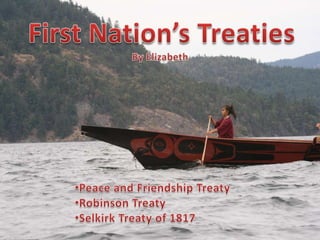First Nations Treaties
- 1. Photo / All sizesLooking for the HTML code and photo file link? Check out this FAQ. First NationĄŊs TreatiesBy Elizabeth Peace and Friendship Treaty
- 3. Selkirk Treaty of 1817Peace and Friendship Treaty
- 5. The Selkirk Treaty of 1817
- 6. THE END.
Editor's Notes
- #3: Peace and Friendship TreatyWho: Mi'kmaq, Maliseet and Passamaquoddy First Nations were signed with the Peace and Friendship Treaty.What: This treaty was an agreement that set out long standing promises, mutual obligations and benefits for the both sides. It involved the First Nations to give the some rights to their land in return they received benefits. The benefits included farm equipment and animals, reserve lands, annual payments, clothing, and certain rights to hunt and fish.When: The treaty was signed prior to 1779. Since 1982, the treaty rights are protected be the Canadian Constitution. Where: This treaty was signed on the upper east coast. It all took place in Canada.Why: Then they made a deal that would benefit both parties. The peace treaty was made to in store peace and cooperation between the Europeans and the First Nations.How: The British Crown entered the treaties to encourage peaceful relations between the Europeans and the First NationsĄŊ. Unlike most treaties, this treaty was not made for the purpose of the Fist NationsĄŊ to sign over their land.Who signed the treaty? Mi'kmaq, Maliseet and Passamaquoddy First Nations groups were signed with the Peace and Friendship Treaty. Other people who signed were the British.Why was the treaty signed?The treaty was signed to in store peace and cooperation between the Europeans and the First Nations. To create harmony among the people is another reason for the treaty to be signed.
- #4: The Robinson TreatyWho:The Robinson Treaty was singed between the Ojibwa chiefs and the British Crown.What: There were three treaties signed that are referred to as Ą°The Robinson TreatyĄą. The three treaties all provided foreigners with land in exchange for material goods or benefits of some form.When: The treaty for the Lake Superior region was signed on September 7, 1850. The first treaty for Lake Huron was signed September 9, 1850. The second treaty for the Lake Superior region was signed on October 13, 1854.Where: The Robinson Superior Treaty was signed and took effect in the Lake Superior region. The Robinson Huron Treaty was entered into agreement in the Lake Huron region, the Surrender of the Saugeen also came into effect in the Lake Huron region. Why: It opened up the land for the foreigners for exploration and exploitation. This treaty became a Ą°loose modelĄą for future treaties in Canada.How: When the treaty was signed, both parties received something to their benefit. The Europeans or foreigners would have used these treaties to their advantage, trying to claim as much land as they could.Who signed the treaty?The treaties were signed between the Ojibwa chiefs and The Crown (the reigning monarch).Why was the treaty signed?The Lake Superior treaty was signed because it enabled The Crown to gain power of the Northern Shore of Lake Superior.The Lake Huron (1) Treaty was singed because it allowed land to be given and explored by The Crown or other authority figures. Also it gave the Europeans permission to explore the land that wanted.The Lake Huron (2) Treaty was signed for a similar reason The Lake Huron (1) was signed.
- #5: The Selkirk Treaty of 1817Who: In 1817, Thomas Selkirk signed a treaty with the Cree, Chippewa, and other nations.What: Thomas Selkirk wanted land to distribute to settlers; he negotiated with some first nationsĄŊ and can up with a treaty that entitles him to land.When: This treaty was signed in 1817. It was the first treaty signed in the West. When Thomas died in 1820, executives of the state controlled and distributed the land. Where: This treaty was signed in RupertĄŊs Land. Thomas received land close to / bordering the Red River.Why: Thomas Selkirk wanted this treaty because the first nations and him were not on the same page. They constantly were angry with each other; which led to much conflict. This resulted in the MĻĶtis killing the governor-in-chief of Rupert's Land and 20 of his men. Selkirk decided to sign a treaty, making everything more peaceful and organized. How: Selkirk got the chiefs of several groups of first nations to sign a treaty; that was documented proof that he owned land, thus resulting is less heated arguments. Why was this treaty signed?This treaty was signed because Thomas Selkirk did not want there to be any more disputes between foreigners and the first nations. He believed that both parties should know whose land is whose and have proof that it actually is. Who signed this treaty?Chiefs and warriors of the Chippewa /Salteaux Nation and of the Killistine or Cree Nation, and Thomas Earl Selkirk all signed the Selkirk treaty.
- #6: Thanks for watching. ?





